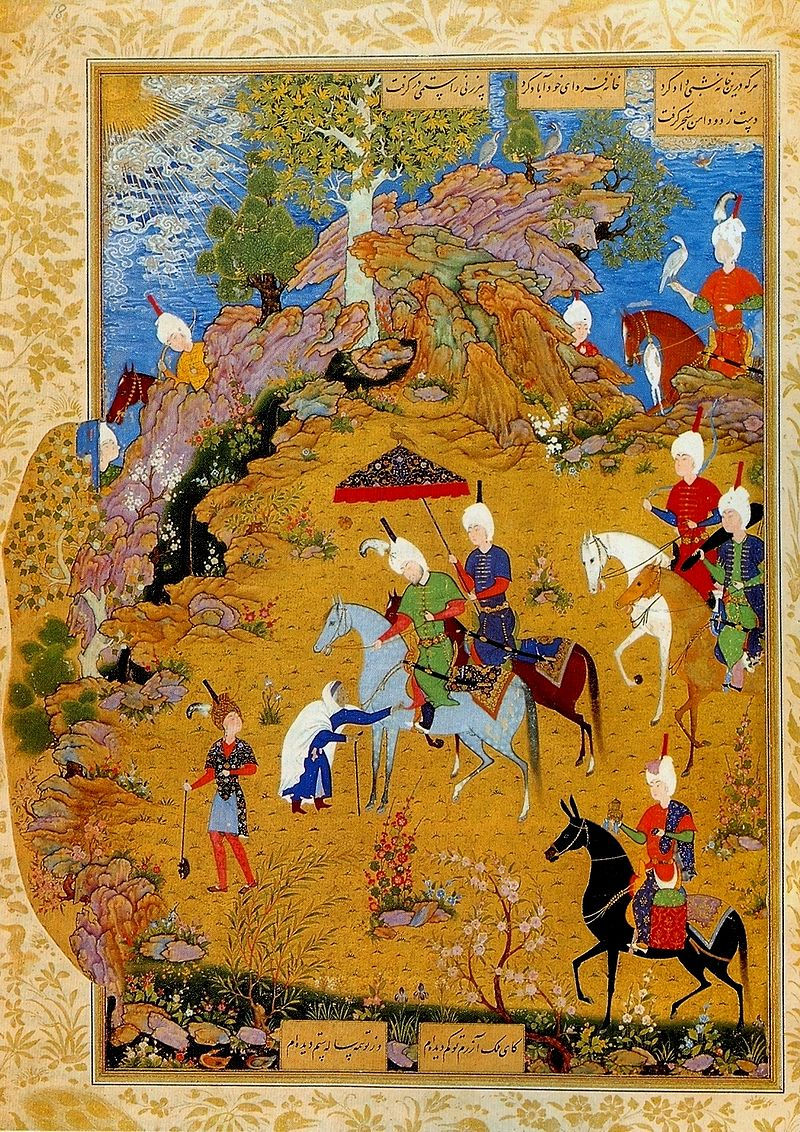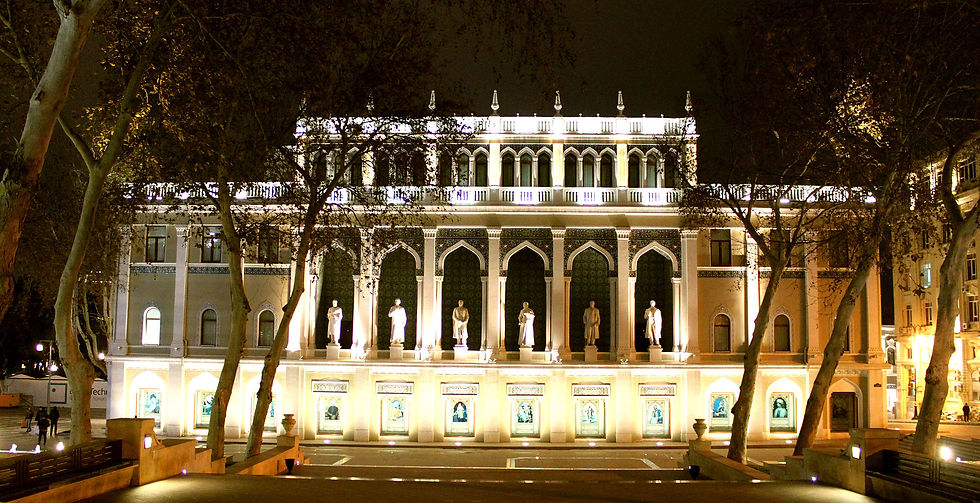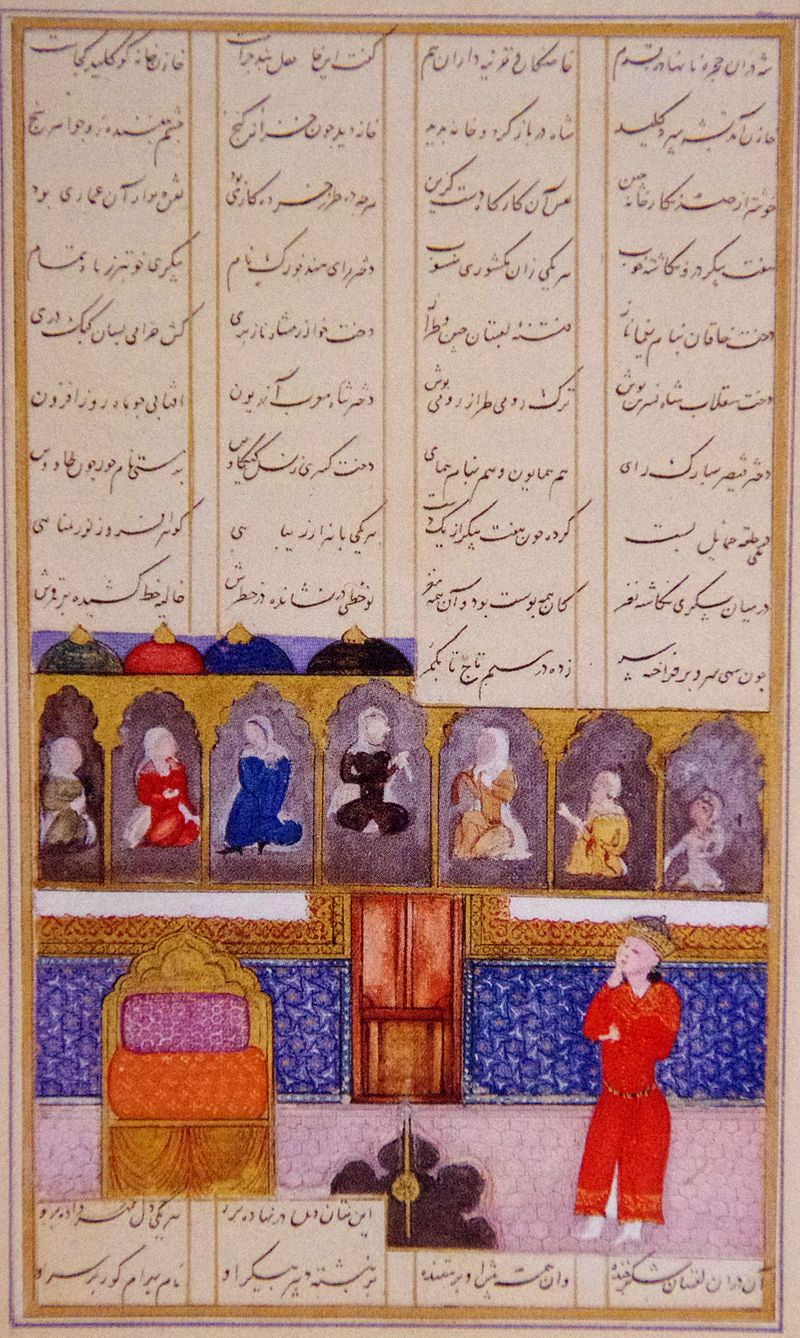

Miniature.

Huseyn Javid, born Huseyn Abdulla oglu Rasizadeh (24 October 1882, Nakhchivan – 5 December 1941, Shevchenko, Tayshetsky District), was a prominent Azerbaijani poet and playwright of the early 20th century. He was one of the founders of progressive romanticism movement in the contemporary Azerbaijani literature. He was exiled during the Stalin purges in the USSR.

Nizami Museum of Azerbaijani Literature

Ismail was a prolific poet who, under the pen name Khataii, contributed greatly to the literary development of the Azerbaijani language.

Nizami Museum of Azerbaijani Literature

Nizami Ganjavi. Seven Beauties. Miniature.

Abdurrahim bey Asad bey oglu Hagverdiyev (17 May 1870 – 17 December 1933) was an Azerbaijani playwright, stage director, politician and public figure.

Nizami Mausoleum in Ganja, Azerbaijan.

Nizami Museum of Azerbaijani Literature
Culture
Literature / Music / Fine arts / Architecture / Theatre & Cinema / Rugs / Museums
Literature
Azerbaijani literature (Azerbaijani: Azərbaycan ədəbiyyatı) refers to the literature written in Azerbaijani, a Turkic language, which currently is the official state language of the Republic of Azerbaijan and is the first-language of most people in Iranian Azerbaijan. While the majority of Azerbaijani people live in Iran, modern Azerbaijani literature is overwhelmingly produced in the Republic of Azerbaijan, where the language has official status. Three scripts are used for writing the language : Azerbaijani Latin script in the Republic of Azerbaijan, Persian alphabet in Iranian Azerbaijan and Cyrillic script in Russia.
The first examples of Azerbaijani literature date to the late 1200s following the arrival of Oghuz Turks in Caucasus and were written in Perso-Arabic script. Several major authors helped to develop Azerbaijani literature from the 1300s until the 1600s and poetry figures prominently in their works. Towards the end of the 19th century popular literature such as newspapers began to be published in Azerbaijani language. The production of written works in Azerbaijani was banned in Iran (Persia) under the rule of Reza Shah (1925–41) and in Soviet Azerbaijan Stalin's "Red Terror" campaign targeted thousands of Azerbaijani writers, journalists, teachers, intellectuals and others and resulted in the changing of the Azerbaijani alphabet into one with a Cyrillic alphabet.
Modern Azerbaijani literature is almost exclusively produced in the Republic of Azerbaijan and despite being widely spoken in Iranian Azerbaijan, Azerbaijani is not formally taught in schools nor are publications in Azerbaijani easily available.
Folklore
The history of folklore, as oral poetic creativity of Azeri people, dates back to the time of first people settlement in the territory of Azerbaijan. Azerbaijan has got one of the richest folklore wealth in the world.
One can still find out rich and deeply meaningful folklore samples in Azerbaijan literature. The signs of mythological and belles-lettres experience are remained both in folklore and classical literature up to day. The mythology of Azerbaijan is not of systematic and full character in comparison with that of the ancient India and the ancient Greek. But it is possible to find out the traces of Azerbaijan mythology in Azerbaijan folklore. They are generally the elements of cosmogonic, seasonal and ethnogonic myths. Those mythic elements, being the result of artistic thinking of primary formation of human society, reflect cosmos and chaos, i.e. mixture in world life, disorder, the creation of world life(order) off this irregularity and the reflection of all this in human society. Cosmos in mythic world-outlook, i.e. rules accepted by most of the people, reflects the process of mutual understanding between the major rule of the society- family, life, man and the nature. Separate details of mythological world-outlook are still remained in the texts concerning sorcery, cheers, curses, tales, godu and the ceremony of counting(sayachy) of the folklore. The old Turkish mythological thinking is the leading motive In the majority of mythological texts. This could be seen cosmogonic myths concerning the creation of the world, as well as in ethnogonic myths concerning the origin of the ethnos and calendar myths concerning season processes. The creation of the mythological texts and their preservation in the form of the elements in folklore texts is closely related with human attitude towards the nature and natural forces. Human desire to effect natural forces by word, movement and dance the provoked necessity to create mythological texts and perform them. For instance, ceremonial songs and dances such as "Kosa-Kosa", "Godu-Godu", "Novruz", "xidir Nabi" are of that kind.
Azerbaijan folklore is rich genres. Tales and epics, proverbs and sayings, reflecting the wisdom of the people, being the genres of epic folklore, greatly influenced the folklore and classic literature of the neighbors. Bayati-the specimen of lyrical genre, has multisided literary-emotional reflection of people life. Ancient Turkish people had their own poetry and it was written in national syllabic and "barmag" ('finger') measures. The number of syllables in different poetic samples is different, but long poems of epical character and epics are generally of seven-syllable form. The poem of such structure is strongly remembered. Bayati-one of the richest genres of Azerbaijan folklore is based on seven syllables.
There are known two kinds of folklore genres-archaic and modern. Sinamalar (believes based on definite actions), sorcery, fortune-telling, oaths, prays, curses take a large position among the genre of archaic folklore. Nevertheless this division is relative, for these genres are widened by new samples appearing during the long history of folklore formation.
According to the character of the event and the process ceremonial folklore and labour songs are known. Ceremonial folklore includes seasonal ceremonies, ceremonies concerning different natural processes, everyday life ceremonies, weddings and funerals.
Bayaties are one of the richest genres of Azerbaijan folklore. The usually reflect lyrical-philosophical feelings of a human being in short poetic form. For instance we may count lulliby, elegy, counting words, holavar(labour poems), vesfi-hal (praising), bayati-baglama, bayati-deyishme(competition in ssaying bayati), bayati-tapmaca(bayati-puzzles) and others as the forms of this genre. Bayati is the form of poem containing of four lines with seven syllable in each. The form of rhyme is as follows: a-a-b-a. Ginas (the form of rhyming ) historically takes a large place in Turkish poetry, so we may come across with bayati samples with ginas, too. One of the forms of bayati is that the first line of which contains only rhyme. Such kind of bayati can generally be seen in Karkuk folklore. The first two lines in bayati are somewhat like entrance to the main meaning.
Folk songs are also among wide-spread folklore genres. These are poetic texts of different form with concrete musical motive. Singers still include such songs as "Aman nene" ("Oh, grandmother"), "Ay lolo", "Sona bulbullar" ('Beautiful nightingales'), "susan sunbul"('iris spike') in their repertoire. Folk song is performed in solo, chorus and wrangling forms.
If the epic folklore genre is to be analyzed chronologically, legends should come the first. The main distinctive feature of the legend is -existence of fantastic elements and events. In comparison with fairy tales, having the same distinctive feature, the subject of the legend is not completed, it exist only in the form of a fragment. Based on the object described and the context of the event legends may be cosmogonic, zoonimic, toponimic, ethnographic, religious, historical, heroic, etc. The oldest legends tell us about the universe, the world and the heavenly body.
Stories, as the wide-spread epic specimen of literature, occupy the next position after legends and tales among the folklore genres of Azerbaijan.
Proverbs and sayings are widely spread among the epic genres of Azerbaijan folklore as well. The proverbs and sayings, as the generalized conclusion and result of people century-old experience, are famous among Turkish people, and in many cases somewhat replaced the moral code in the society. The first samples of this genre could be seen in such classical written monuments as "Divanu lugat-it-turk" by Mahmud Kashgari, "Kitabi- Dada Gorgud" ("The book of old Gorgud"). Special proverbs collection-"Oguzname"z, reflecting wisdom of Turkish tribes are invaluable monuments of Azerbaijan folklore as well.
The dramatic genres of Azerbaijan folklore are represented by folk games ans square performances. The drama of "Kosa-Kosa" is the best example to the said. Well known among the people shabihs, based on the tragedy of the family of prophet, appeared after acceptance of Islam, are also included into the folk dramas.
A great group of folklore specimen of Azerbaijan had specially been created for children. They are of lyric, epic and dramatic content. Lyric includes the genres of lulliby and child songs; epic includes puzzle, tongue-twisted, garavelli; drama includes children games and performances.
Middle centuries occupy a particular place among the levels of evolution of Azerbaijan folklore. In this period of XII-XVIII centuries, the genre of epos had specially been developed. Great artists like Gurbani, Tufarganli Abbas, Sari Ashig, Xasta Gasim are the lived and created at this period. This period is also popular with the appearance of such love eposes as "Gurbani", "Ashig Garib-Shahsanam", "Asli-Kerem", "Abbas-Gulgas", " Shah Ismail- Gulzar", "Nahir-Zohra", 'Alikhan-Peri', 'Arzu-Gamber', mainly connected with irfan, and heroic epos 'Koroglu'. In comparison with love eposes 'Koroglu' is the collection of different branches, thus continues the tradition of "Dada Gorgud" epos. That is why it is called epos. Though the main subject of "Koroglu" is based ob the concrete historical event- the movement of Jalairilar in Azerbaijan and Turkey in the XVI-XVII, some extra subjects were added to the monument in the process of formation. Here and there one can find mythic motives.
For the reason that the specimen of folklore are anonym, i.e. they do not have an author, ashug literature with concrete authors occupies a particular place in Azerbaijan folklore. The great representatives of art of ashug, foundered in XVI century and still existing up today, are called "ustad ashuglar"-"masters". The firs master ashug in Azerbaijan folklore was Gurbani. Gurbani was elder than Shah Ismail Khatai(1478-1524) and there was some kind of attitude between them. One can take some information about this artist from the history of Sefevids and epos "Gurbani".
Three hundred year long traditions of ashug art reed in the XIX century the great artist of people, Ahug Alesker(1821-1926). In the creation of Ashug Alesker lyrical and moral-didactic motives joined as a whole. The great artist influenced posterior ashug literature and the development of written poem. During 105 year long life, ashug reflected many historical events and persons in his creative activity.
Azerbaijan oral folk creation, especially the art of ashug, deeply influenced the literature of neighboring people, for many of Georgian and Armenian poets wrote in Turkish. Savat Nova, XVIII century Armenian poet, created majority of his works in Turkish(Azeri), the language which his descendants unsympathise.
In written form The first specimen of Azerbaijan folklore came to our times by Herodot, the ancient Greek historian, in "History" (V cent, B.C.). They are the reflection of people literary thinking concerning the reasons of collapsing Midia, an ancient Azerbaijan state, and its occupation by Iran. The legends "Astiyag", 'Tomris' and others found their written reflection in the work of Herodot. Herodot, the work of which is not only the historical , but also a kind of fiction, literarily worked out Azerbaijan legends and created effective psychological scenes. The legend of 'Tomris' deserves special attention from this aspect. Heroin Tomris, the warlord of Midia which was destroyed by shah(king) of Iran, defeated the shah cutting of his head and sinking it into the barrel of blood, so that 'he could quench his blood thirst'…
Mythological aspect in the myth of 'Astiag' is stronger. The main event are based here on dreams and forecast. The weakness of a man in changing the fate defined by divine powers has been presented in the example of Astiag tragedy. Same motives are widely spread in most ancient literatures, as well as ancient Greek literature.
The greatest specimen of Azernaijan folklore remained in written form till our days is the epos "Kitabi- Dada Gorgud". Though different characters and motives of the epos influenced the following Azerbaijan folklore and classic literature, it has not been preserved thoroughly in oral generation. So 'Dada Gorgud' the eposes is also investigated as the specimen of written literature. The same principle is preserved in this article.
National Museum of Azerbaijan literature named after Nizami Ganjavi: www.nizamimuseum.az.
Literature / Music / Fine arts / Architecture / Theatre & Cinema / Rugs / Museums
